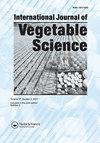镁对番茄的生长、产量、养分吸收和果实品质均有影响
IF 1.1
Q2 Agricultural and Biological Sciences
引用次数: 2
摘要
摘要番茄(Solanum lycopersicum L.)由于不正确或不使用镁(Mg)而导致产量低。本试验于2018-2019年10月至2019-2020年3月和2019-2020年3月进行,旨在确定Mg对番茄产量和品质的有效剂量,并评估番茄的养分吸收和利用效率。处理分别为0(对照)、4、8、12和16 kg·ha−1的镁。施用12 kg·ha - 1 Mg可产生最多的单株果实(41.1个),最重的果实(74.3 g)和最高的果实产量(69.7 t∙ha - 1)。施用12 kg·ha - 1 mg时,果实中维生素C含量最高,为39.6 mg/100 g。相同处理的番茄成熟果实中β-胡萝卜素含量最高(26.1µg·g−1),果实硬度提高(1.06 kg -force),蛋白质含量提高(18.8%)。在12 kg·ha - 1 Mg时养分吸收效果最好。Mg的回收利用效率最高,为8 kg·ha−1 Mg。12 kg·ha - 1 Mg处理的毛利率最高,为48.6%,效益成本比为3.11。施用12 kg·ha - 1 Mg似乎可以提高番茄的数量、质量和经济性。回归分析表明,在田间控制条件下,Mg @ 11.3 kg·ha−1对番茄产量的提高效果最佳。本文章由计算机程序翻译,如有差异,请以英文原文为准。
Magnesium influences growth, yield, nutrient uptake, and fruit quality of tomato
ABSTRACT The yield of tomato (Solanum lycopersicum L.) is low due to incorrect or use of no magnesium (Mg). An experiment was conducted from October to March 2018–2019 and 2019–2020 to determine the effective dose of Mg to improve yield and quality, and assess nutrient uptake and use efficiency of tomato. Treatments were magnesium at 0 (control), 4, 8, 12, or 16 kg·ha−1. Application of 12 kg·ha−1 Mg produced the most fruit per plant (41.1), heaviest fruit (74.3 g), and greatest fruit yield (69.7 t∙ha−1). Vitamin C content in fruit was best (39.6 mg/100 g) with application of 12 kg·ha−1 Mg. The same treatment had the highest β-carotene (26.1 µg·g−1), improved fruit firmness (1.06 kilogram-force), and had better protein content (18.8%) in mature tomato fruit. Uptake of nutrients was best with 12 kg·ha−1 Mg. Recovery use efficiency of Mg was highest with 8 kg·ha−1 Mg. The best gross margin (48.6%) and benefit-cost ratio (3.11) was with 12 kg·ha−1 Mg. Application of 12 kg·ha−1 Mg appears to improve the quantity, quality, and economics of tomatoes. Regression analysis indicated application of Mg @ 11.3 kg·ha−1 could be optimum to improve the yield of tomatoes under controlled field conditions.
求助全文
通过发布文献求助,成功后即可免费获取论文全文。
去求助
来源期刊

International Journal of Vegetable Science
Agricultural and Biological Sciences-Plant Science
CiteScore
3.10
自引率
0.00%
发文量
30
期刊介绍:
The International Journal of Vegetable Science features innovative articles on all aspects of vegetable production, including growth regulation, pest management, sustainable production, harvesting, handling, storage, shipping, and final consumption. Researchers, practitioners, and academics present current findings on new crops and protected culture as well as traditional crops, examine marketing trends in the commercial vegetable industry, and address vital issues of concern to breeders, production managers, and processors working in all continents where vegetables are grown.
 求助内容:
求助内容: 应助结果提醒方式:
应助结果提醒方式:


